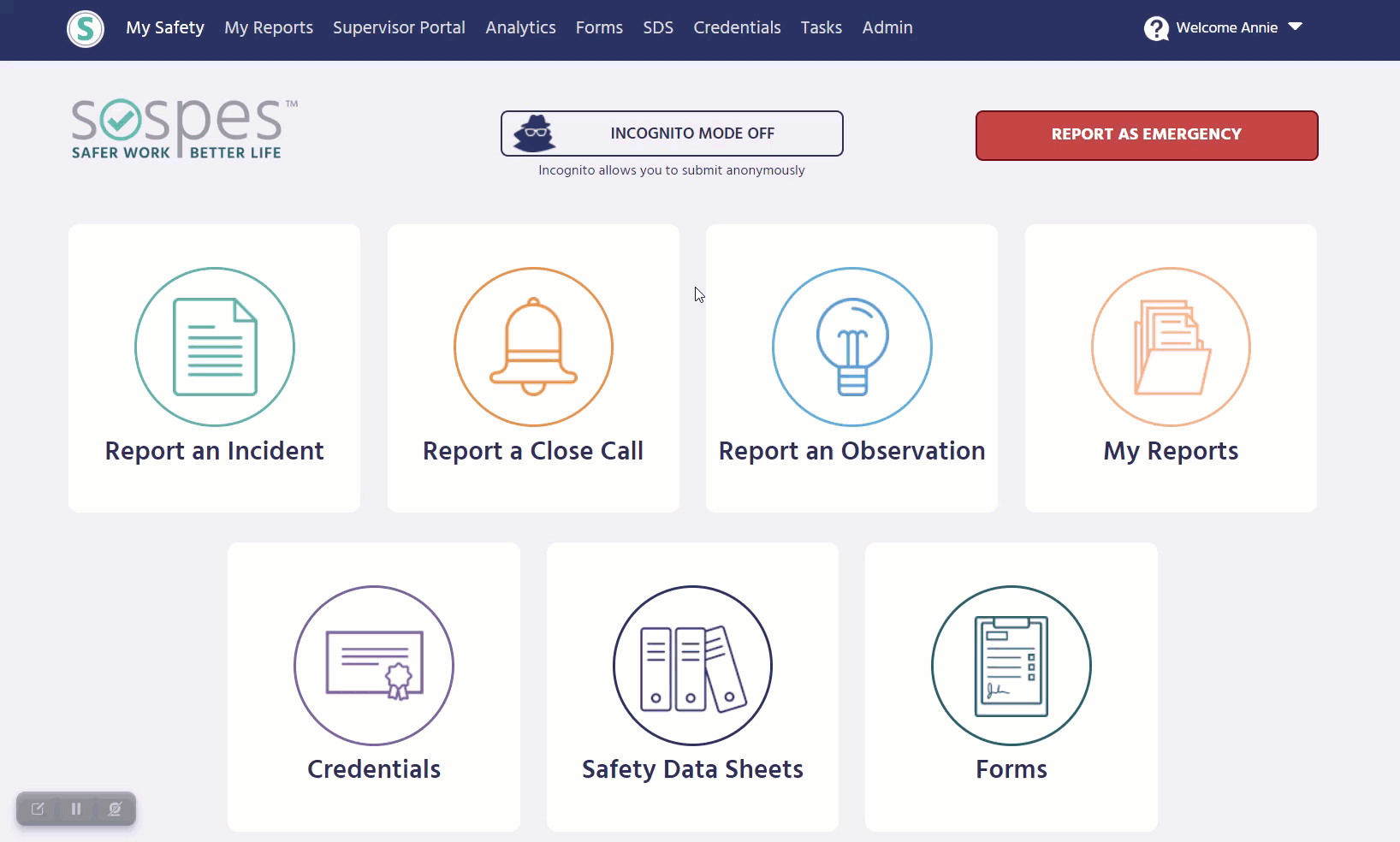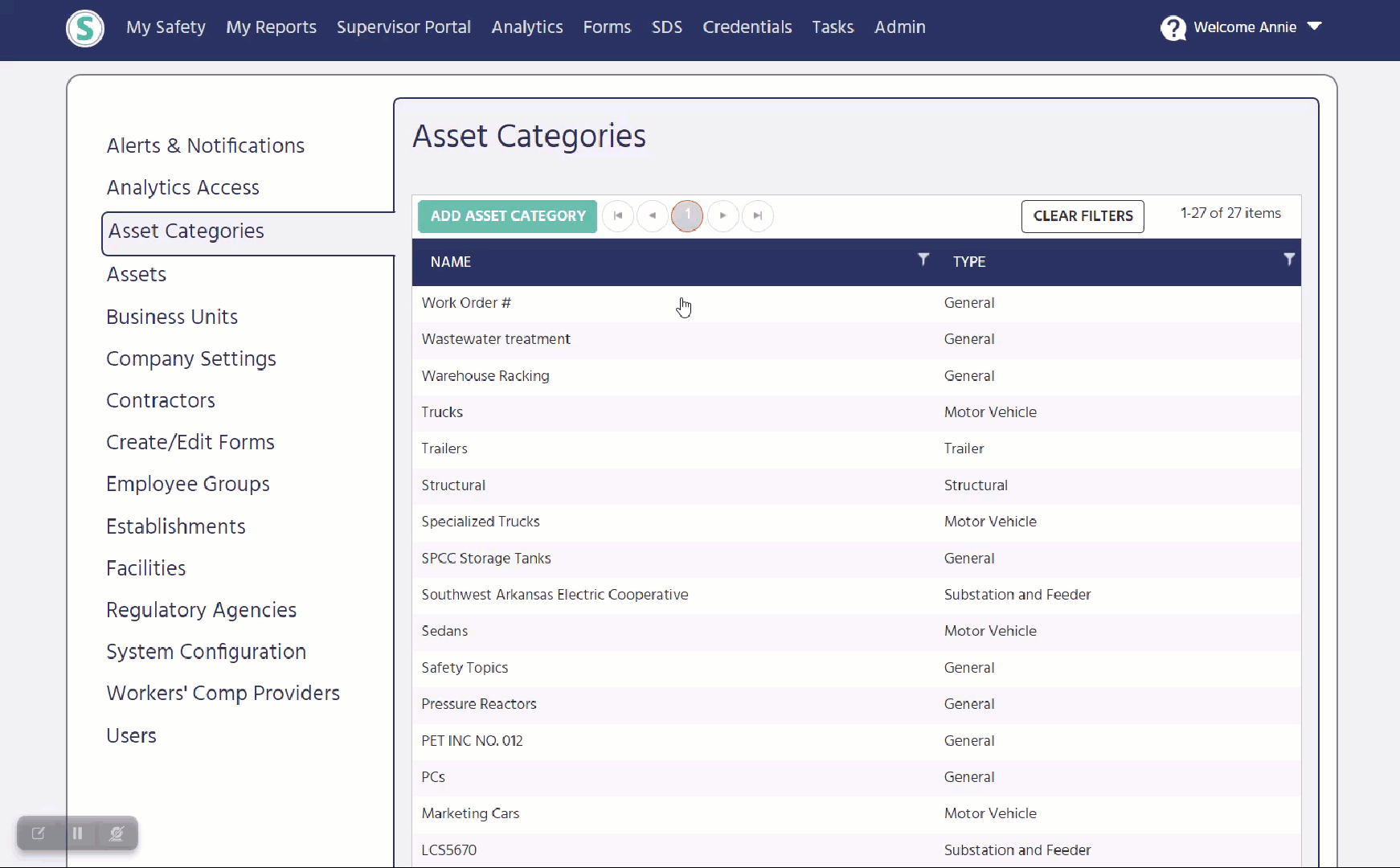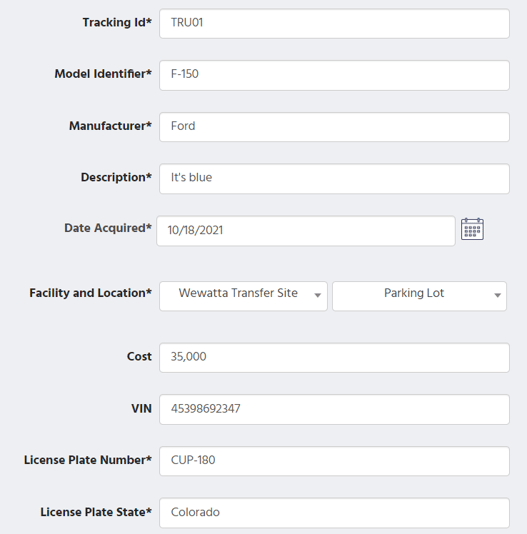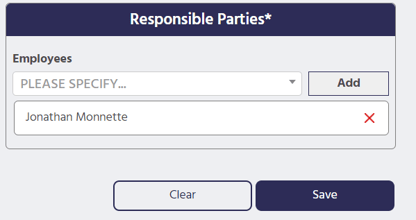Assets & Asset Categories
Learn how to create asset categories, lists, and navigate/sort the lists in the Admin tool.
Assets & Asset Categories
Sospes can store all of your institution's assets and asset categories, making it easy to attach specific asset details to your reports!

Asset Categories
Creating Asset Categories
Before setting up specific assets, you will need to determine asset categories. Asset categories are general groupings of the assets and equipment you have at various facilities and locations.
Asset categories fall under five broader categories: motor vehicle, trailer, substation/feeder, structural, or general.
- To set up your asset categories, click on the Admin tab at the top of the page.
- Along the left-hand side of the page, click Asset Categories.
- Click Add Asset Category and a new window will appear to Create Asset Category.
- In the textbox next to Name type the name of the asset, for example, “Trucks.”
- Next to Asset Category Type click the arrow to open the dropdown menu and choose a category type: motor vehicle, trailer, substation, and feeder, or general. Going back to our example of a “truck” asset, the category type would be “motor vehicle.”
- Under the Responsible Parties header, click the textbox under Employees to open a dropdown menu of all employee names in the system. You can also search for an employee name by typing the first or last name of the employee in the SEARCH textbox at the top of the dropdown list.
Click on the employee name that would be responsible for this particular asset.

NOTE: The responsible party is a person or group of people who are associated with that asset and they may receive different alerts regarding that asset depending on how alerts and notifications are configured.
- Once the employee name is selected and appears in the textbox, click Add to the right of the employee name and the name of the employee will appear in an additional textbox below. To remove an employee name as a responsible party, click the red “X” to the right of the employee name.
- Click Save.
Asset Categories List
From the Asset Categories page, you can see the list of asset categories that have already been created in your Sospes environment, with the name of the asset category and the type of asset category.
To view a list of current asset categories in the system, click Admin at the top of the page.
- Along the left-hand side of the page near the bottom of the list, click Asset Categories.
- A window will appear entitled Asset Categories which will give you a directory list of all of the asset categories that are in your Sospes environment.
- To view the details of an asset category, double-click anywhere on the line of that particular asset category.
Sorting Asset Categories List
From the Asset Categories page, you can sort the category list by clicking on one of the column names found in the dark blue banner at the top. You can sort by either Name or Type.
-png.png)
- For example, to view the asset category list by name, click NAME in the dark blue banner at the top of the list of asset categories.
- If you click once, the list will be sorted in alphabetically ascending order by the name of the category.
- If you click twice, the list will be sorted in alphabetical descending order.
Searching Asset Category List
You also have the option to search for a specific asset category or narrow down your list of asset categories by creating specific search criteria.
-png.png)
For example, you can search for a specific asset category like, “Forklift.” To do this, click the search icon to the right of the column header you would like to search by, either NAME or TYPE. A pop-up window will open below:
Defining your search values:
- Under Show items with value that: click on the first textbox Is equal to and a dropdown menu will open.
- This will give you the following options for your search criteria:
- Is equal to
- Is not equal to
- Starts with
- Contains
- Does not contain
- Ends with
- Click the search criteria you would like to use, and it will appear in the textbox.
- Click the blank textbox below the search criteria you selected and type the numerical values of your search.
And/Or:
- You can further define your search values by clicking the textbox And. A dropdown menu will appear with two options:
- And
- Or
- Click the search criteria you would like to use, and it will appear in the middle textbox.
Further defining your search values:
- You can even further define your search values by clicking the third textbox Is equal to and another dropdown menu will open.
- This will give you the following options for your search criteria:
- Is equal to
- Is not equal to
- Starts with
- Contains
- Does not contain
- Ends with
- Click the search criteria you would like to use, and it will appear in the textbox.
- Click the blank textbox below the search criteria you selected and type the numerical values of your search.
Filter:
Once you have set the search criteria, click Filter. The results of your search will appear on the page.
Reset:
To reset your search results and return to the complete list of asset categories:
- Click the search icon to the right of
- A pop-up window will open below.
- At the bottom of the pop-up window, click Clear.
- You will be returned to a complete list of asset category information.
- You can also clear the search filter by clicking Clear Filters at the top right of the page.
-png.png)
Navigating Asset Categories Pages
If there are multiple pages to your asset category list, next to the ADD ASSET CATEGORY button you will see circular buttons containing the number of pages that are in the list, as well as navigation buttons.
-png.png)
- To go to a specific page in the asset categories list, click on the page number.
- To go to the next page of asset categories, click the arrow forward button.
- To go back to the previous page, click the arrow backward button.
- To go to the last page in the asset categories list, click the last page button.
- To go to the first page in the asset categories list, click the first-page button.
Assets
Once asset categories are added, you can create and manage specific, individual assets and equipment.
-png.png)
Creating Assets
- To set up your assets, click on the Admin tab at the top of the page.
- Along the left-hand side of the page, click Assets.
- Click Add Asset and a new window will appear to Create Asset.
- Next to Asset Category, click the arrow to open the dropdown menu and choose a category type. You can also search for a category by typing the category name next to SEARCH until it appears in the list.
- Click the category name and it will appear in the textbox. For example, if you are adding a Ford F-150 truck, you would select the category that best fits that asset, such as “Trucks.”
- Next to Tracking Id, type the tracking ID number and/or name associated with this specific asset. The Tracking ID is the name or serial number that users will look up when searching for each item. This can be serial numbers, common names, or other identifier types. This is what shows up in the dropdown list.
*This is the name or serial number that users will look up when searching for each item. This can be serial numbers, common names, or other identifier types. This is what shows up in the drop-down. - Next to Model Identifier, type the model name of the asset. This is the unique model of the asset. For example, “F-150.”
- Next to Manufacturer, type the manufacturer of the asset. This will show up in the dropdown list. For example, “Ford.”
- Next to Description, type the description of the specific asset. For example, “It’s blue.”
- Next to Date Acquired, type the date of when your organization originally purchased or acquired this asset. If you do not have this information, you can enter the current date.
- Next to Facility and Location, click the first text box to the right PLEASE SPECIFY and a dropdown list will appear with the facilities of your company. Click the facility in which this specific asset is located. You can also click SEARCH and begin typing the name of the facility until it appears in the list. Click the name of the facility so that it appears in the textbox. For example, “WeWatta Transfer Site.”
- Next to Facility and Location, click the second text box to the right PLEASE SPECIFY and a dropdown list will appear with the locations at your company’s facilities. Click the location of which this specific asset is located. You can also click SEARCH and begin typing the name of the location until it appears in the list. Click the name of the location so that it appears in the textbox. For example, “Parking Lot.”
- Next to Cost, type the approximate original cost of this asset. This must have a value so if you don't have a cost, just type 0.
- Under the Responsible Parties header, click the textbox under Employees to open a dropdown menu of all employee names in the system. Click on the employee name that would be responsible for this particular asset. You can also search for an employee's name by typing the first or last name of the employee in the SEARCH textbox at the top of the dropdown list.

- Once the employee name is selected and appears in the textbox, click Add to the right of the employee name and the name of the employee will appear in an additional textbox below. To remove an employee name as a responsible party, click the red “X” to the right of the employee name.
- Click Save.

Asset List
From the Assets page, you can see the TRACKING ID, FACILITY, ASSET CATEGORY, MODEL IDENTIFIER, and if the asset IS ACTIVE.

- To view a list of current assets in the system, click Admin at the top of the page.
- Along the left-hand side of the page, click Assets.
- A window will appear entitled Assets which will give you a list of all active assets that are in your Sospes environment.
- To also view assets that are inactive, on the top right of the page, click the textbox next to Show inactive until a green checkmark appears.
-png.png)
- To view only active assets, click the green checkmark next to Show inactive to remove the checkmark.
-png.png)
Sorting Assets List
From the Assets page, you can sort the asset list by clicking on one of the column names found in the dark blue banner at the top. You can sort by either TRACKING ID, FACILITY, ASSET CATEGORY, MODEL IDENTIFIER, or IS ACTIVE.
- For example, to view the asset list by facility, click FACILITY in the dark blue banner at the top of the list of assets.
-png-1.png)
- If you click once, the list will be sorted in alphabetically ascending order by the facility name.
- If you click twice, the list will be sorted in alphabetical descending order.
Searching Asset List
You also have the option to search for a specific asset or narrow down your list of assets by creating specific search criteria.
For example, to find an asset, you can search for a specific Tracking ID number. Or to narrow down your list to display only assets at a specific facility, you can search by a facility name.
-png.png)
To do this, click the search icon to the right of the column header you would like to search by, either TRACKING ID, FACILITY, ASSET CATEGORY, or MODEL IDENTIFIER. A pop-up window will open below:
-png.png)
Defining your search values:
- Under Show items with value that: click on the first textbox Is equal to and a dropdown menu will open.
- This will give you the following options for your search criteria:
- Is equal to
- Is not equal to
- Starts with
- Contains
- Does not contain
- Ends with
- Click the search criteria you would like to use, and it will appear in the textbox.
- Click the blank textbox below the search criteria you selected and type the numerical values of your search.
And/Or:
- You can further refine your search values by clicking the textbox And. A drop down menu will appear with two options:
- And
- Or
- Click the search criteria you would like to use, and it will appear in the middle textbox.
Further defining your search values:
- You can even further define your search values by clicking the third textbox Is equal to and another dropdown menu will open.
- This will give you the following options for your search criteria:
- Is equal to
- Is not equal to
- Starts with
- Contains
- Does not contain
- Ends with
- Click the search criteria you would like to use, and it will appear in the textbox.
- Click the blank textbox below the search criteria you selected and type the numerical values of your search.
Filter:
Once you have set the search criteria, click Filter. The results of your search will appear on the page.
Reset:
To reset your search results and return to the complete list of assets:
- At the top right-hand corner of the page, click Clear Filters.
- You will be returned to a complete list of asset information.
Navigating Asset Pages
If there are multiple pages in your asset list, next to the ADD ASSET button you will see circular buttons containing the number of pages that are in the list, as well as navigation buttons.
- To go to a specific page in the asset list, click on the page number.
- To go to the next page of assets, click the arrow forward button.
- To go back to the previous page, click the arrow backward button.
- To go to the last page in the asset list, click the last page button.
- To go to the first page in the asset list, click the first page button.
